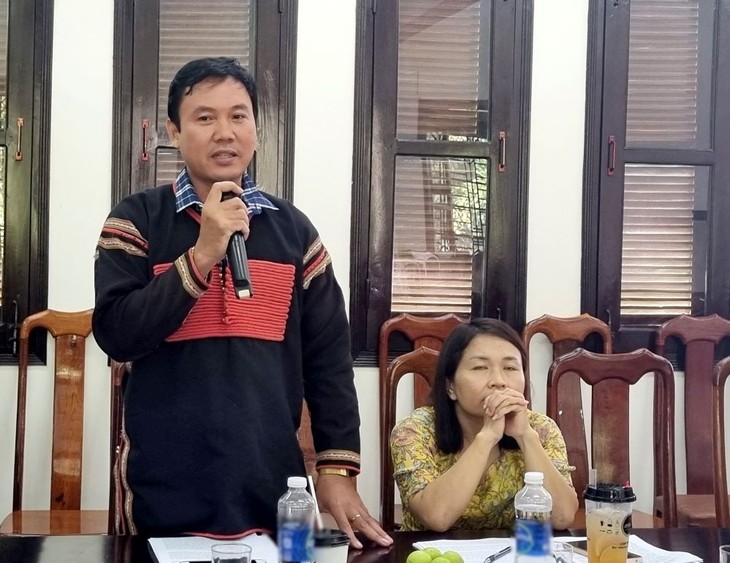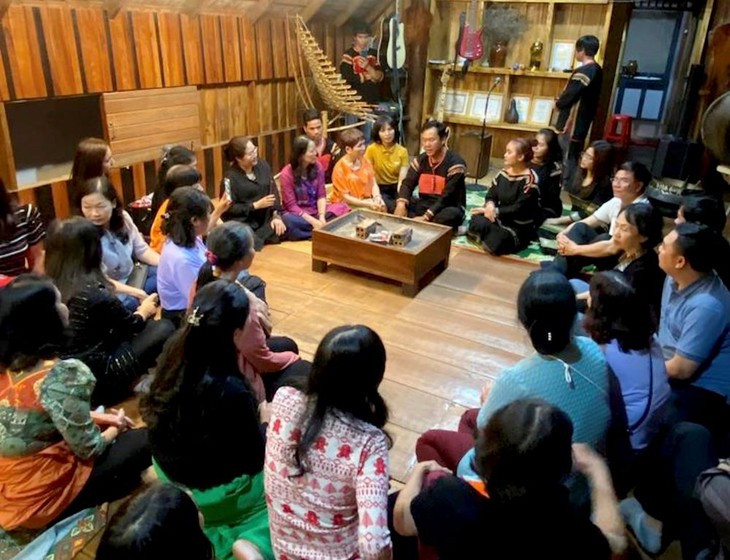(VOVWORLD) - The epics of the Central Highlands are narratives of heroic legends. For the local ethnic minorities, these epics embody their history, culture, and life experience and reflect their life in this land over thousands of years.
 Young artisan Y Won Knul introduces the epic of Mdrong Dam. (Photo: VOV) Young artisan Y Won Knul introduces the epic of Mdrong Dam. (Photo: VOV) |
Sitting by the fireplace in a long house in Dak Lak province, young artisan Y Won Knul slowly recites the story of Mdrong Dam, a hero in the epics of the Ede ethnic minority. His story is full of mythical characters, village life, and the ancient traditions and culture of the Ede.
Knul says the Central Highlands epics were a part of his childhood and will never fade from his mind and soul.
“When I was a child, I lived in a long stilt house. My childhood was associated with the sound of gongs and epics. At that time, I didn’t really understand their meaning. It’s amazing that our predecessors could invent such long, lively stories. The older I get, the better I understand and enjoy them,” said Knul.
Living in the cultural space of the epics gives Knul and other local people the opportunity to absorb this form of folk literature. What distinguishes the Central Highlands epics from epics in other areas is they are not written down but transmitted orally from memory through regular community activities.
The Central Highlands epics are heroic narratives known by different names, depending on the ethnic group – ‘Khan’ by the Ede, ‘Hom’ by the Bahnar, ‘Hri’ by the Gia Rai, and ‘Ot nrong’ by the Mnong.
In the world's folklores, the Central Highlands epics are one of the most extensive. They vividly and honestly reflect community life and the struggle for dignity. The stories center on heroic legends and the characters do not represent individuals but are heroic prototypes who represent the aspirations of the community and the struggle for human ideals.
“Each epic work tells a story related to many themes. Some are about war and tribal unification. Others depict the themes of marriage, family life, production, and religious practices and beliefs. The epics paint a comprehensive picture of the economy and society of ethnic groups in the Central Highlands,” Assoc. Prof. Dr. Tuyet Nhung of Central Highlands University said.
 Central Highlands epics are often recited at community events such as ceremonies, funerals, and weddings. (Photo: VOV) Central Highlands epics are often recited at community events such as ceremonies, funerals, and weddings. (Photo: VOV) |
The epics are often recited at community events – ceremonies, funerals, and weddings – with everyone sitting around a fire. There are epics that can be told in one night, but there are also epics that take a week to tell.
“I' m pleased that the State promulgated a policy of organizing classes to teach epic recitation and gong playing. We hope the younger generations will continue to preserve and promote the epics so that people will become acquainted with our unique narrative form,” said Meritorious artisan Y Wang H Wing.
The Vietnam Academy of Social Sciences collected, preserved, translated and published 800 Central Highlands epics in the 2001-2008 period. The collection includes 5,700 90-minute audio tapes. And there are still many epics that have never been recorded.
In 2014, Central Highlands epics were recognized as a National Intangible Cultural Heritage by the Ministry of Culture, Sports, and Tourism.